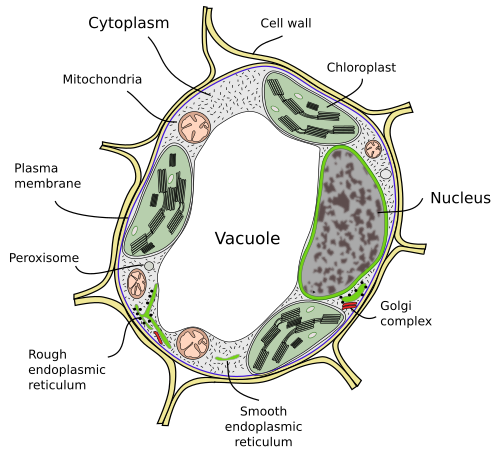Cytology (generally known as cell biology) is the topic of this part of the website (The atlas of plant and animal histology). We will primarily deal with the organization of the eukaryote cell. But what is a cell? The following may be a good definition: cells are the anatomical and functional units of living organisms. Cells may be found alone or in groups as multicellular organisms. A single cell is the simplest molecular organization that is considered as alive. Three cell lineages are known to be present on Earth: archaea and bacteria, which are unicellular prokaryotes, and eukaryotes, which can be unicellular or form multicellular organisms. Prokaryotes (meaning prior to the presence of a nucleus) do not usually show internal membrane bound compartments, while eukaryotes (meaning containing a true nucleus) always contain internal membrane bound organelles.
Every cell, whether prokaryote or eukaryote, is a complex and highly organized set of molecules. In fact, cells have many internal compartments with specific functions. Let's say that a cellular compartment is a space, delimited or not by a membrane, where a necessary or important function for the cell is performed. One of the compartments found in every cell is the cell membrane, also known as plasmalemma or plasma membrane, which encloses all the other cell compartments. The plasma membrane is a semipermeable barrier that separates the inner cell space from the extracellular space.
Eukaryotic cells have internal membrane bound compartments. The nucleus is one of them. It is bounded by a double membrane and contains the genetic material known as DNA (DeoxyriboNucleic Acid). DNA stores the information the cell needs to carry out tasks for reproduction and survival. The space between the nucleus and the plasma membrane is filled with the cytosol, an aqueous gel that contains a wide variety of molecules involved in structural and metabolic functions, homeostasis, signaling, and many other requirements of cellular life. For example, the ribosomes are involved in protein synthesis, the cytoskeleton is necessary for internal cell organization and movement, and many enzymes and co-factors are in charge of metabolism. Between the cell membrane and the nucleus, surrounded by the cytosol, there are many organelles, membrane bound compartments, which perform functions such as digestion, respiration, photosynthesis, metabolism, intracellular transport, secretion, energy production, storage, etc. Mitochondria, chloroplasts, peroxisomes, lysosomes, endoplasmic reticulum, and vacuoles are some of these organelles. The cytoplasm is the cytosol plus all organelles, excluding the nucleus. See Figures 1 and 2.


Compared to eukaryote cells, prokaryote cells (bacteria and archaea) are generally described as lacking organelles. Although this is true in most prokaryote cells, there are internal membrane bound compartments in some prokaryotes. The membranes of these compartments are usually continuous with the plasma membrane, that is, they are actually inward folds (invaginations) of the plasma membrane. Four types of internal prokaryote membrane bound compartments have been observed: thylakoids, chlorosomes, magnetosomes and carboxysomes.
In the following pages, we will take a tour through the different compartments of the eukaryotic cell and extracellular environment. Some parts of cell function will not be addressed in depth here, such as gene expression or cell metabolism. It would take a large amount of space, which would undermine the idea we want to give about the cell. Furthermore, there are many outstanding Internet sites about those subjects. The different "places" of the cell that we are going to "visit" are shown on the right side panel.
